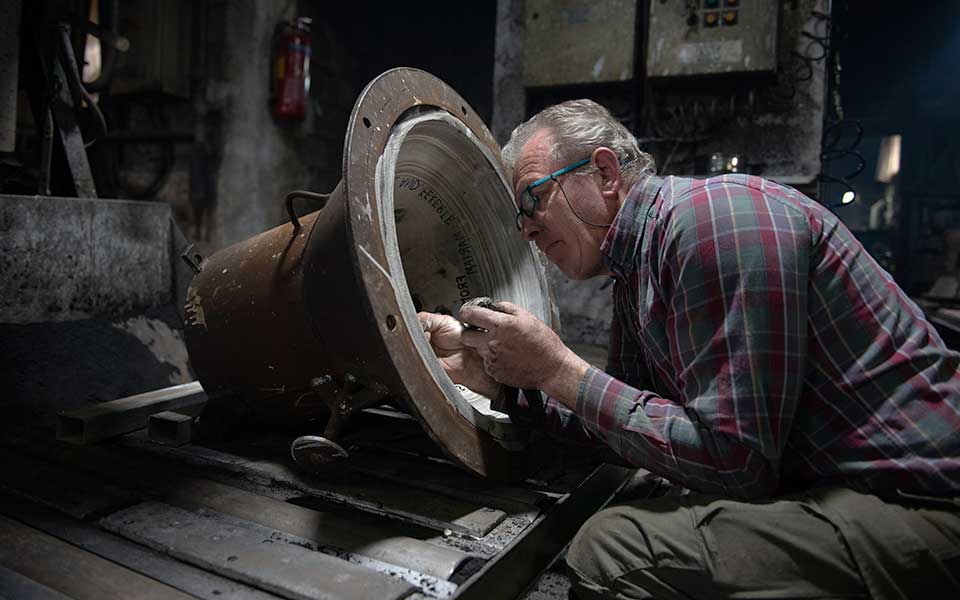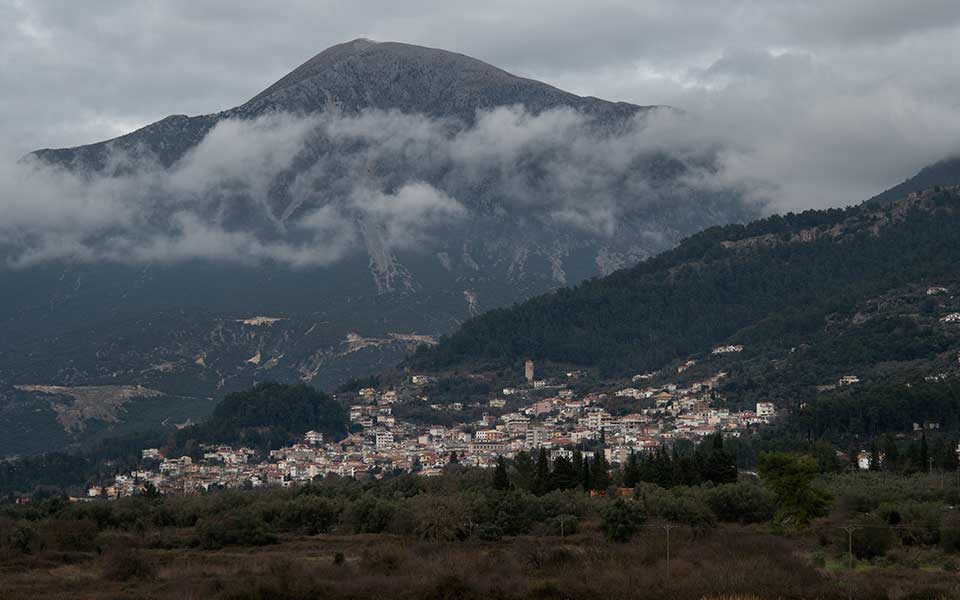Christmas in Epirus
Whether it’s the charming town of...

The Galanopoulos family workshop is one of two remaining bell-makers in Greece.
© Alexandros Avramides
Thomas carefully climbs the steps next to the furnace. The molten metal is bubbling at 1500◦ C. The white-haired man stretches out his hand, feeling the heat. “It’s low; it needs more.” His son and his nephew respond immediately, running to add more metal to the pot before stepping away.
The atmosphere is stiflingly hot. Through a small widow, we can see the metal fighting the fire, and succumbing slowly to its power. At the end of the process, a ton of copper and tin has been transformed into a thick orange-red liquid.

The village of Paramythia in Thesprotia, part of the mountainous Epirus region of northwest Greece.
© Alexandros Avramides

The men of the Galanopoulos family at work in the foundry.
© Alexandros Avramides

Thomas Galanopoulos, the oldest surviving member of the family, is keeping alive a centuries old family tradition.
© Alexandros Avramides
The molten metal which will be poured carefully into molds is the raw material for the Galanopoulos brothers’ famous bells. From their workshop in Paramythia in Thesprotia, their bells, large and small, have traveled to the far corners of the earth: Greece, Germany, Kenya, Tanzania, Australia and the United States. They make more than a thousand bells a year.
The Galanopoulos family workshop is one of two remaining bell-makers in Greece. The craft is slowly dying out, but the Galanopoulos brothers persist. Their story is one of striving and survival.

The craft of bell-making is slowly dying out, but the Galanopoulos family is determined to persist.
© Alexandros Avramides

The workshop produces more than a thousand bells a year.
© Alexandros Avramides
“I have been making bells for over fifty years. My father and my grandfather before me did the same. It’s a family tradition which goes back 200 to 250 years,” says Thomas Galanopoulos, the oldest surviving member of the family. He took over the family business after his father was killed in an accident. He was just 12 years old.
Thomas never considered doing anything else in his life other than making bells. When he grew up, he toured the bell-makers of Europe to see how things were done in other countries. On his return, he invested in the business, converting the shed left to him by his father in the 1970s into a modern workshop.
“If we had stayed as we were, we would have had no chance of surviving. We needed to have production. I didn’t want to waste a two-centuries-old business.”

Thomas Galanopoulos: "When the copper and tin boil in the furnace, the heat burns your body and the smoke fills your nostrils."
© Alexandros Avramides

Thomas' son Fotis, who hopes to build the business further, wants to specialize in ornate bells with lettering and reliefs.
© Alexandros Avramides
Despite the advent of modern machinery, bell-making still requires experience and manual labor. With a hand-rolled cigarette permanently in his hand, Thomas carefully supervises each stage in the process. “The secret to a good sound lies in the mold,” he explains.
After that comes the melting of the metal, the pouring, the cleaning of the bell and, finally the most important moment of all, checking the “voice” of the bell. Thomas admits the work has become easier since he was a child, but it continues to be demanding. When the copper and tin boil in the furnace, the heat burns your body and the smoke fills your nostrils. When the molten metal hits the mold it emits a terrible choking smell. The reward, he says, comes later, when the bell is delivered to those who have ordered it.
“The greatest pleasure comes in installing the bell. What people feel when they see you ringing the bells passes through you and thrills you. The pleasure it gives people is amazing. There is no better feeling for me,” he says.
The Galanopoulos brothers have toured the world in recent years, climbing the tallest bell-towers in America, Africa and Europe to install their bells. Their biggest bell, though, is to be found in Greece. It weighs three and a half tons and rings out from the bell-tower of the Church of Saint Joseph the Betrothed and Saint Photini in Evosmos, Thessaloniki.

Thomas and Christos Galanopoulos with their sons, who are determined to follow the family tradition.
© Alexandros Avramides
Thomas’s biggest success is that the next generation has inherited the family’s love of the craft. His son and his nephew, both named Fotis after their grandfather, have started work in the workshop, eager to continue the tradition.
“I have been coming here since I was a boy. I made the wires that held the little clappers of the small bells we made for the flocks, and I enjoyed it. I feel great satisfaction continuing a trade which is dying out, and a business which my father and uncle worked hard to build,” says Thomas’ son Fotis, who hopes to build the business further. He wants to specialize in ornate bells with lettering and reliefs, and to use the foundry to make other objects as well.
“I’ll be delighted to see my children’s children in this workshop,” says Thomas, clearly proud of the two boys. Leading me out, he takes me around the yard of the workshop, with a view of the mountains. There, he and his brother have collected old bells, some dating to as far back as the 18th century. Alongside the workshop, they want to build a museum in which to exhibit these marvelous examples of the bell-maker’s craft, objects which bear the signatures of now-dead craftsmen. They hope to create their own monument to the craft which the family has served for so very long.
This article was first published in Greek on kathimerini.gr.
Whether it’s the charming town of...
As autumn deepens, Ioannina glows with...
One of the most impressive canyons...
Discover five mountain destinations where crisp...